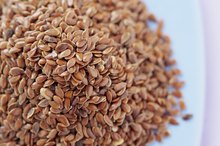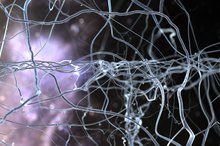The Best Supplements for ADD/ADHD
ADHD -- attention deficit hyperactivity disorder -- is one of the most common disorders of childhood 1. Its symptoms often persist into adulthood as well, and may negatively impact learning, work and home life. There are three types of ADHD, according to the National Institute of Mental Health. Some people with ADHD are primarily hyperactive, some are primarily inattentive and some exhibit a combination of symptoms. Supplements may help ADHD inattentives. Before taking any supplements, consult a qualified health care professional to find out if they are right for you.
Tyrosine
Julia Ross writes in her book, "The Mood Cure," that tyrosine is a useful supplement for ADHD patients and others who feel flat, tired and easily distracted. Ross claims that increased alertness and focus can sometimes be seen as quickly as 10 minutes after ingestion. Tyrosine, an amino acid, is a key player in the synthesis of neurotransmitters in the brain involved with mood and motivation. Abundant in high protein foods including soy products, cheeses, turkey, fish and nuts, it can also be taken in supplement form. Like other supplements, tyrosine should be used under the supervision of a qualified health care professional.
- Julia Ross writes in her book, "The Mood Cure," that tyrosine is a useful supplement for ADHD patients and others who feel flat, tired and easily distracted.
Magnesium
Foods to Calm ADHD Children
Learn More
The mineral magnesium plays a role in more than 300 metabolic reactions. Natalie Sinn, a researcher affiliated with the School of Health Sciences at the University of South Australia, wrote in the journal "Nutrition Reviews" that an astonishing 95 percent of children with a diagnosis of ADHD were found to have low levels of magnesium in their bloodstreams. Moreover, the children with the lowest levels of magnesium were the most inattentive. Sinn described several studies of ADHD patients in which supplemental magnesium improved hyperactivity, school performance and distractibility. Green leafy vegetables, nuts and unrefined grains are good sources of magnesium. Magnesium can also be obtained through high-quality multivitamins or from individual supplements. Consult a qualified health care professional before adding magnesium to your child's or your own dietary regimen.
- The mineral magnesium plays a role in more than 300 metabolic reactions.
- Natalie Sinn, a researcher affiliated with the School of Health Sciences at the University of South Australia, wrote in the journal "Nutrition Reviews" that an astonishing 95 percent of children with a diagnosis of ADHD were found to have low levels of magnesium in their bloodstreams.
Pine Bark Extract
The extract derived from the bark of the maritime pine, a tree that is grown in a large forest in France near Bordeaux, may be a useful herbal supplement for ADHD and a number of other health conditions. Natalie Sinn writes that pine bark extract may enhance the flow of blood to the brain. This is important because impaired cerebral blood flow has been implicated in ADHD. Sinn describes a scientific study in which children with ADHD symptoms were treated with either pine bark extract or an inactive placebo. Parent and teacher ratings of concentration and attention improved significantly for the group that received the pine bark extract. However, the use of pine bark extract is not an adequate replacement for advice and treatment from a qualified health care professional.
- The extract derived from the bark of the maritime pine, a tree that is grown in a large forest in France near Bordeaux, may be a useful herbal supplement for ADHD and a number of other health conditions.
Related Articles
References
- "Nutrition Reviews"; Nutritional and Dietary Influences on Attention Deficit Hyperactivity Disorder; N. Sinn; October 2008
- "The Mood Cure: The 4-Step Program to Rebalance Your Emotional Chemistry and Rediscover Your Natural Sense of Well-Being"; Julia Ross; 2002
- Adler, L, Spencer, T. et al. Best practices in adult ADHD: Epidemiology, impairments, and differential diagnosis. CNS Spectr . 2008;13(S12):18-18. doi:10.1017/S1092852900003151
- Bruchmüller K, Margraf J, Schneider S. Is ADHD diagnosed in accord with diagnostic criteria? Overdiagnosis and influence of client gender on diagnosis. Journal of Consulting and Clinical Psychology. 80(1):128-138. doi:10.1037/a0026582
- Skogli EW, Teicher MH, Andersen PN, Hovik KT, Øie M. ADHD in girls and boys – gender differences in co-existing symptoms and executive function measures. BMC Psychiatry. 2013;13(1). doi:10.1186/1471-244X-13-298
- Fresson M, Meulemans T, Dardenne B, Geurten M. Overdiagnosis of ADHD in boys: Stereotype impact on neuropsychological assessment. Applied Neuropsychology: Child. 2019;8(3):231-245. doi:10.1080/21622965.2018.1430576
- Rucklidge JJ. Gender differences in attention-deficit/hyperactivity disorder. Psychiatric Clinics of North America. 2010;33(2):357-373. doi:10.1016/j.psc.2010.01.006.
- Visser SN, Danielson ML, Bitsko RH, et al. Trends in the parent-report of health care provider-diagnosed and medicated attention-deficit/hyperactivity disorder: United States, 2003-2011. J Am Acad Child Adolesc Psychiatry. 2014;53(1):34-46.e2. doi:10.1016/j.jaac.2013.09.001
- Russell AE, Ford T, Russell G. Socioeconomic associations with ADHD: Findings from a mediation analysis. PLoS ONE. 10(6):e0128248. doi:10.1371/journal.pone.0128248
- Paris J, Bhat V, Thombs B. Is adult attention-deficit hyperactivity disorder being overdiagnosed?. Can J Psychiatry. 2015;60(7):324-8. doi:10.1177/070674371506000705
- Coates J, Taylor JA, Sayal K. Parenting interventions for ADHD. J Atten Disord. 2015;19(10):831-843. doi:10.1177/1087054714535952
- Hansson Halleröd SL, Anckarsäter H, Råstam M, Hansson Scherman M. Experienced consequences of being diagnosed with ADHD as an adult – a qualitative study. BMC Psychiatry. 2015;15(1). doi:10.1186/s12888-015-0410-4
- Holbrook JR, Cuffe SP, Cai B, et al. Persistence of parent-reported ADHD symptoms from childhood through adolescence in a community sample. J Atten Disord. 2016;20(1):11-20. doi:10.1177/1087054714539997
- Miller DJ, Derefinko KJ, Lynam DR, Milich R, Fillmore MT. Impulsivity and attention deficit-hyperactivity disorder: Subtype classification using the UPPS impulsive behavior scale. J Psychopathol Behav Assess. 2010;32(3):323-332. doi:10.1007/s10862-009-9155-z
- Faraone SV, Biederman J, Mick E. The age-dependent decline of attention deficit hyperactivity disorder: a meta-analysis of follow-up studies. Psychol Med. 2006;36(2):159-165. doi:10.1017/S003329170500471X
- Turgay A, Goodman DW, Asherson P, et al. Lifespan persistence of ADHD. J Clin Psychiatry. 2012;73(02):192-201. doi:10.4088/JCP.10m06628
- Torrente F, Lischinsky A, Torralva T, López P, Roca M, Manes F. Not always hyperactive?: Elevated apathy scores in adolescents and adults with ADHD. J Atten Disord. 2011;15(7):545-556. doi:10.1177/1087054709359887
- Konrad K, Eickhoff SB. Is the ADHD brain wired differently? A review on structural and functional connectivity in attention deficit hyperactivity disorder. Hum Brain Mapp. 2010;31(6):904-916. doi:10.1002/hbm.21058
- Young S, Sedgwick O. Attention deficit hyperactivity disorder and substance misuse: an evaluation of causal hypotheses and treatment considerations. Expert Review of Neurotherapeutics. 2015;15(9):1005-1014. doi:10.1586/14737175.2015.1059756
- American Psychiatric Association, DSM-5 Task Force. Diagnostic And Statistical Manual Of Mental Disorders, DSM-5. Fifth Edition. Arlington, VA, US: American Psychiatric Association Publishing; 2013. doi:10.1176/appi.books.9780890425596
- Asherson P, Akehurst R, Kooij JJS, et al. Under diagnosis of adult ADHD. J Atten Disord. 2012;16(5_suppl):20S-38S. doi:10.1177/1087054714535952
- Bihlar Muld B, Jokinen J, Bölte S, Hirvikoski T. Long-term outcomes of pharmacologically treated versus non-treated adults with ADHD and substance use disorder: A naturalistic study. Journal of Substance Abuse Treatment. 2015;51:82-90. doi:10.1016/j.jsat.2014.11.005
- Brodersen J, Schwartz LM, Heneghan C, O’Sullivan JW, Aronson JK, Woloshin S. Overdiagnosis: What it is and what it isn’t. BMJ EBM. 2018;23(1):1-3. doi:10.1136/ebmed-2017-110886
- Child and Adolescent Health Measurement Initiative. National Outcome Measure 17.4: Percent of Children, Ages 3 through 17, Diagnosed with Attention Deficit Disorder/Attention Deficit Hyperactivity Disorder (ADD/ADHD.; 2019). childhealthdata.org
- Coker TR, Elliott MN, Toomey SL, et al. Racial and ethnic disparities in ADHD diagnosis and treatment. PEDIATRICS. 2016;138(3):e20160407-e20160407. doi:10.1542/peds.2016-0407
- Derks EM, Hudziak JJ, Boomsma DI. Why more boys than girls with ADHD receive treatment: A study of dutch twins. Twin Res Hum Genet. 2007;10(5):765-770. doi:10.1375/twin.10.5.765
- Fayyad J, Sampson NA, Hwang I, et al. The descriptive epidemiology of DSM-IV Adult ADHD in the World Health Organization World Mental Health Surveys. ADHD Atten Def Hyp Disord. 2017;9(1):47-65. doi:10.1007/s12402-016-0208-3
- Lui JHL, Johnston C, Lee CM, Lee-Flynn SC. Parental ADHD symptoms and self-reports of positive parenting. Journal of Consulting and Clinical Psychology. 81(6):988-998. doi:10.1037/a0033490
- MANOS MJ, GIULIANO K, GEYER E. ADHD: Overdiagnosed and overtreated, or misdiagnosed and mistreated? Cleve Clin J Med. 2017;84(11):873-880. doi:10.3949/ccjm.84a.15051
- Sciutto MJ, Eisenberg M. Evaluating the evidence for and against the overdiagnosis of ADHD. J Atten Disord. 2007;11(2):106-113. doi:10.1177/1087054707300094
- Wilens TE, Morrison NR. The intersection of attention-deficit/hyperactivity disorder and substance abuse. Current Opinion in Psychiatry. 2011;24(4):280-285. doi:10.1097/YCO.0b013e328345c956
Writer Bio
Cindy Ell began writing professionally in 1990. A former medical librarian, she has written materials for hospitals, medical associations, the "Nashville Scene" and "Coping Magazine." She received her Bachelor of Arts in linguistics from the University of Massachusetts and her Master of Library and Information Science from Pratt Institute. She is currently a full-time freelance medical writer.









